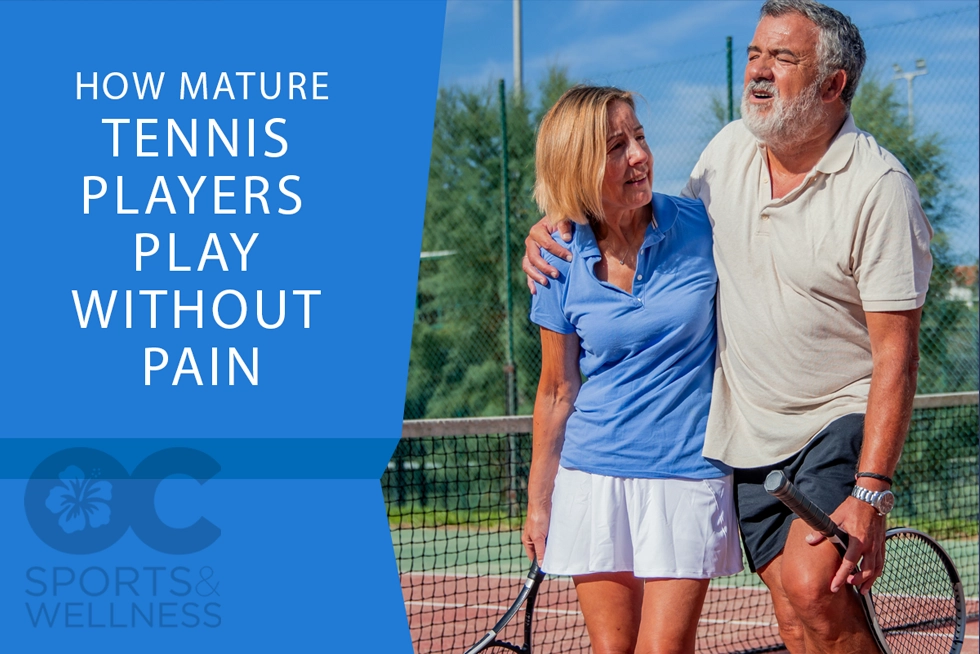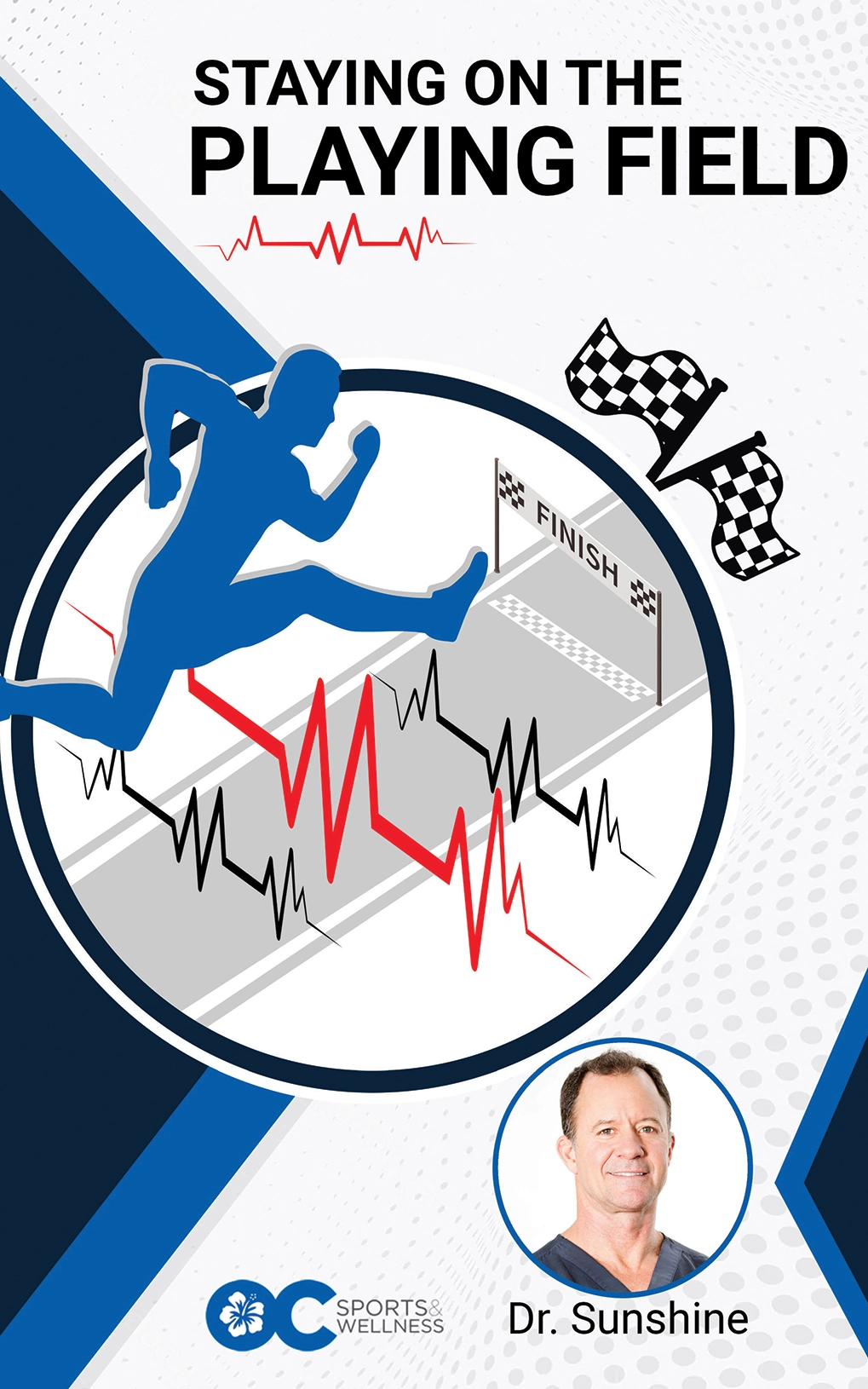How Tennis Players Over 50 Can Keep Playing — Without Pain
Getting older doesn’t mean giving up the sport you love. If you’re 50 or older and want to keep playing tennis comfortably, this guide is for you. It explains why pain happens, what you can do right away, and how to recover when injuries occur — all in clear, practical language. As the premier sports medicine clinic in Orange County, OC Sports and Wellness specializes in helping mature tennis players stay on the court with less pain and more confidence.
Why do older players get hurt more often?
Tennis involves quick starts, sudden stops, twisting, and repeated smashing motions. Over time, these forces accumulate. Players over 50 commonly experience issues in the shoulder, elbow, knee, ankle, and Achilles, and hips — plus general muscle soreness and flare-ups of arthritis. Older athletes also heal more slowly than younger players, so what starts as a minor irritation can develop into a more significant problem if left unattended. Studies show that the shoulder, thigh/hip/pelvis, and knee are frequent sites of injury in tennis players, and injuries in older adults account for a significant portion of sports-related orthopaedic problems.
Big-picture approach:
play smart, stay strong, and recover well
The best long-term strategy is simple: prevent avoidable stress, build and keep key physical capacities, and treat injuries early. That means three main pillars:
- Thoughtful preparation — warm up and manage your playing time effectively.
- Strength and stability — maintain muscle, joint control, and balance.
- Smart recovery and medical care — rest, targeted treatments, and early evaluation when pain persists.
Before you play: warm-up and preparation that work
A focused, 8–15 minute warm-up primes your body and reduces the risk of injury. Things to include:
- Light aerobic movement (3–5 minutes) — brisk walking or gentle jogging to raise body temperature.
- Dynamic mobility — leg swings, arm circles, and gentle trunk rotations to free up the joints.
- Short sport-specific drills — slow rallying, half-speed volleys, and controlled serves before full effort.
- Activation work — short sets of glute bridges, banded side steps, or calf raises to “wake up” key muscles.
Following these steps regularly helps you move more efficiently and reduces the sudden strain that can lead to injuries.
Manage load: play smarter, not just harder.
It’s easy to overdo it when you’re feeling good. Smart players track volume and intensity, including the number of matches, the duration of practices, and the number of high-effort points they play. Simple rules:
- Limit very intense sessions to a few times per week and add low-intensity rallies or cross-training days.
- When returning from pain, reduce time on court by 25–50% and build back gradually.
- Mix surfaces and footwear — softer surfaces and well-cushioned shoes can reduce joint stress.
Strength, balance, and mobility —
the home routine that helps the most
For players over 50, preserving strength and balance is one of the most powerful ways to stay pain-free. National guidelines recommend that older adults engage in regular muscle-strengthening exercises to support mobility and reduce the risk of injury.
Here are some simple and safe exercises you can do three times a week. Aim for 1–3 sets of 8–15 reps depending on your fitness level:
- Squat or sit-to-stand — builds leg power for quick court movement.
- Single-leg balance holds — 20–40 seconds per leg to reduce ankle and knee injuries.
- Glute bridges — strengthens the hips and protects the lower back and knees.
- Calf raises (slow, controlled) — supports Achilles and ankle resilience.
- Band rows and shoulder blade squeezes — helps shoulder health and posture.
- Gentle rotator cuff isometrics — hold low-effort positions to maintain shoulder stability.
If any movement causes sharp pain, stop and seek evaluation — gentle soreness is acceptable, but sharp or worsening pain is not.
Pain management when things flare up
If pain starts, these basic steps often help right away:
- Reduce the aggravating activity. Reduce the volume and intensity of high-intensity points.
- Control pain and swelling. Short-term icing (10–15 minutes), elevation (for lower limb swelling), and sensible short-term over-the-counter pain relievers can help. Follow the dosing directions and consult with Dr. Sunshine if you have any medical conditions or are taking other medications.
- Gentle movement and mobility. Complete rest is rarely ideal. Pain-free mobility and gentle strengthening often accelerate recovery more than remaining completely inactive.
- Use supportive gear when appropriate. A forearm brace for tennis elbow, a simple knee sleeve for mild knee pain, or proper shoes can reduce symptoms while you recover.
If pain persists beyond a week or two, or if it limits your daily life, see Dr. Sunshine for an evaluation. Early assessment prevents minor problems from escalating into major ones.
Treatments OC Sports and Wellness commonly uses
OC Sports and Wellness focuses on treatments that help alleviate pain and restore function, allowing you to continue playing. We emphasize individualized medical evaluation and a targeted plan. Some options that may be considered — depending on your diagnosis — include:
- Medically guided injections and biologic options — for particular tendon and joint problems, targeted injections (such as platelet-rich plasma or other biologic approaches) may be considered. Evidence for the use of platelet-rich plasma is mixed for certain conditions, such as lateral epicondylitis (tennis elbow), so a careful discussion with Dr. Sunshine about the likely benefits and risks is essential.
- Ozone-based therapies and other regenerative approaches — emerging research shows promise for ozone in musculoskeletal care for selected conditions, but like all treatments, it must be matched to the right problem and patient. Dr. Sunshine evaluates whether advanced options are appropriate for you.
- Targeted injections for arthritis or focal joint pain — when pain is driven by joint inflammation, specific injections can reduce pain and improve mobility while you work on longer-term strategies.
Important: No single treatment is suitable for everyone. Dr. Sunshine will recommend the least invasive, best-supported option for your situation and goals.
Common problems and practical tips
Tennis elbow (lateral epicondylitis)
Symptoms: Pain on the outside of the elbow, worsened by gripping or backhand strokes.
Practical tips: Reduce repetitive gripping, use a forearm counterforce strap during play, perform gentle eccentric wrist exercises when tolerated, and seek medical assessment if pain limits play for more than a week or two. Discuss the risks and expected outcomes of various treatments with Dr. Sunshine.
Shoulder pain (rotator cuff or bursitis)
Symptoms: Ache or sharp pain with serving or overhead motions, weakness, or trouble reaching overhead.
Practical tips: Emphasize shoulder-blade control, gradually strengthen the rotator cuff and scapular muscles. Limit high-speed serving while symptoms improve. Consider a medical review if weakness or persistent pain develops. Studies have identified the shoulder as a common site of injury among tennis players.
Knee, hip and thigh issues
Symptoms: Front, inside, or outside knee pain; hip or groin discomfort; thigh strains during quick sprints.
Practical tips: Prioritize lower-body strength (quads, glutes, hamstrings), avoid sudden spikes in playtime, use proper footwear, and address movement mechanics if recurring pain occurs. Research shows that lower-limb injuries are common and that older adults have a higher rate of sports-related orthopaedic injury.
Achilles and ankle problems
Symptoms: Calf pain, stiffness, or sudden sharp pain (which could signal a tear).
Practical tips: Calf strengthening (including slow heel lowers when appropriate), avoid abrupt increases in intensity, and have sudden severe pain evaluated immediately. Achilles ruptures are seen in middle-aged players and require urgent assessment.
Smart return-to-play steps
When pain settles and strength returns, follow a staged return-to-play plan:
- Start with low-intensity rallies and short sessions (15–30 minutes).
- Gradually increase time and intensity across several sessions — for example, increase court time by 10–25% every few days if pain-free.
- Reintroduce serving and sprinting last, because they place higher stress on shoulders and lower limbs.
- Monitor symptoms and scale back if pain returns.
Everyday habits that support long-term play
- Sleep and nutrition: adequate sleep and protein support recovery.
- Hydration and electrolytes: prevent cramps and reduce fatigue during long sessions.
- Weight management: maintaining a healthy weight lowers joint load.
- Equipment checks: updated shoes and the right racket grip size reduce injury risk.
When to see a sports medicine specialist
See Dr. Sunshine at OC Sports and Wellness if you have:
- Sharp or worsening pain that doesn’t improve with a few days of rest and basic care.
- Noticeable weakness, repeated instability, or a sudden inability to perform everyday activities.
- Recurring problems that limit your enjoyment of tennis despite self-care.
Dr. Sunshine provides comprehensive medical evaluations and evidence-based treatment options to help you return to play safely and efficiently.
We believe in you!
Staying active and playing tennis after the age of 50 is absolutely possible. With the proper warm-up, sensible load management, routine strength and balance exercises, and timely medical care when needed, most players can continue to enjoy the game with less pain. If you want expert help, Dr. Sunshine is ready to evaluate your symptoms, guide recovery, and create a plan so you can stay on the court longer and with more confidence.
We hope this information is helpful. At OC Sports and Wellness in Orange County, we understand the importance of balancing your health with a busy lifestyle. That’s why we offer convenient options for scheduling visits, texting, or video chatting with Dr. Sunshine. Let’s work together towards your well-being! Feel free to reach out to us at 949-460-9111.

Our sports medicine practice is within driving range of Aliso Viejo, Anaheim, Brea, Buena Park, City of Orange, Costa Mesa, Cypress, Dana Point, Fountain Valley, Fullerton, Garden Grove, Huntington Beach, Irvine Sports Medicine, La Habra, La Palma, Laguna Beach, Laguna Hills, Laguna Niguel, Laguna Woods, Lake Forest, Los Alamitos, Mission Viejo, Newport Beach, Placentia, Rancho Santa Margarita, San Clemente, San Juan Capistrano, Santa Ana, Seal Beach, Stanton, Tustin, Villa Park, Westminster, and Yorba Linda. We look forward to seeing you soon!
Disclaimer: The information above is educational and not a substitute for personalized medical advice. Outcomes vary. Always consult a qualified healthcare professional to determine the best treatment for your condition.


